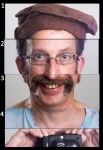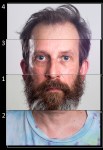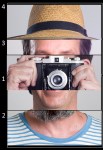We dress like students, we dress like housewives,
or in a suit and a tie
I changed my hairstyle, so many times now,
I don’t know what I look like!
from Life During Wartime: David Byrne (1979)
-

-
33325
-

-
252214
-

-
431316
-

-
12616
-

-
566442
-

-
243135
-

-
341453
-

-
161164
-

-
224313
-

-
233152
-

-
31125
-

-
542361
-

-
566163
A quick check of my wallet and the pockets of my jacket at any time over the last six months would have revealed at least three – and sometimes as many as six – cards or documents whose sole purpose was to identify me to one representative of authority or another. All of them contain at least one head and shoulders photograph conforming to a very tight set of specifications relating to expression, background, angle, whether I wear my glasses or not and so on.
All these photographs are different. They each seem to freeze the me that existed at some moment in time. None of them looks particularly like the me who stared back at me out of the bathroom mirror this morning. Even moments after they had been taken – and the oldest of them still in use is almost exactly 18 years old now – they fall in some way short of how I perceive myself and indeed what I hope other people see when they look at me.
I can create personas based upon them – there’s harrassed-middle-aged-dad me (my driving licence) and chained-to-a-radiator-in-Beirut me (my work pass) – or I can grimace slightly (making me look a bit like an older, even-more-harrassed-middle-aged-dad me, I suspect) and pass through the particular gate where they give me access…
Here are another thirteen pictures of me, again made according to a strict set of rules but this time of my own devising. I have to believe (and officials need to believe) that, for a fraction of a second I once looked like the person in the pictures in my wallet and jacket. All the pictures here are identifiable as me (even # 224313) and each of them contains elements of a me that existed over the course of one day in May 2016.
But I have never looked like any of them. Not even for a fraction of a second.
If you want to conjure more Simon’s from the remaining traces of the Simon that existed on the eighth of May 2016, feel free to go here and follow the instructions.
And do let me know how you get on.
Thanks to:
Rob™, Sean Groundwater, Maciek Bernatt-Reszczynski, Owain Rich, Thea Downie, Blas Gonzales, Lee Hard, Anne Bryson, Chris Lawry, Hilary Farrow, Holly Woodward, Richard Brown Sam Bennett, Richard Down, Emma Pocock, Miri Comber, Stephen Barney, Doug Bell, Stan Dickinson, Dawn Langley, Dave Emrys Newton


























